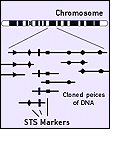|
 Previous Event | Next Event Previous Event | Next Event 
1989: Sequence-tagged Sites, Another Marker
 A sequence-tagged site (STS) is a unique stretch of DNA that polymerase chain reaction (PCR) can easily detect. STSs are very useful for making physical maps of human chromosomes. Creating a physical map is much like putting together a large puzzle, where the pieces of the puzzle are pieces of DNA made by cutting up chromosomes. PCR can be used to test whether STSs are present within different fragments of DNA and accurately assign the DNA fragments to their proper places on the chromosomes. A sequence-tagged site (STS) is a unique stretch of DNA that polymerase chain reaction (PCR) can easily detect. STSs are very useful for making physical maps of human chromosomes. Creating a physical map is much like putting together a large puzzle, where the pieces of the puzzle are pieces of DNA made by cutting up chromosomes. PCR can be used to test whether STSs are present within different fragments of DNA and accurately assign the DNA fragments to their proper places on the chromosomes.
More Information
Reference:
Olson, M., Hood, L., Cantor, C., Botstein D. A Common Language for Physical Mapping of the Human Genome. Science, 245:1434-5. 1989. [Full Text] 
To view this PDF you will need Adobe Acrobat Reader. 
 Previous Event | Next Event Previous Event | Next Event 
Last Reviewed: April 15, 2008
|

